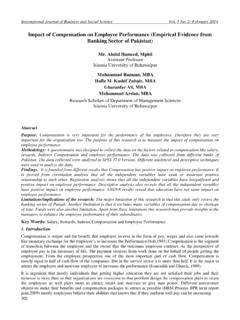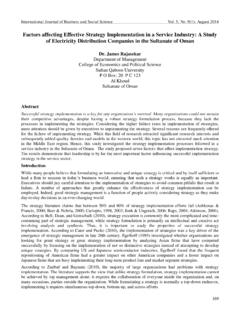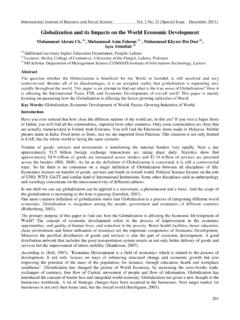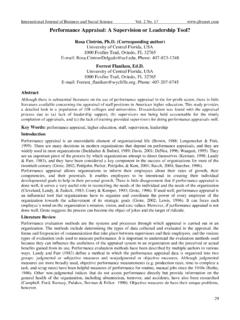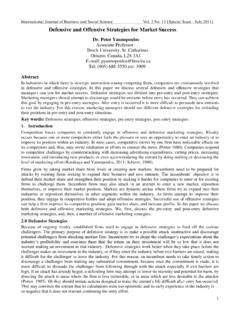Transcription of Cross-cultural Differences in Management
1 International Journal of Business and Social Science Vol. 3 No. 6; [Special Issue -March 2012] 105 Cross-cultural Differences in Management Tagreed Issa Kawar Princess Sumaya University for Technology P. O. Box: 1438 Al-Jubaiha 11941 Amman Jordan Abstract This research aims at studying Cross-cultural Differences in Management . There are areas in Management whereby Differences towards attitudes, behaviours, functioning, communication issues and cultural implications can be seen. Cross-cultural Differences stem from the different backgrounds of each culture . Cultural varieties may be witnessed in the workplace, and there are other factors introduced such as reaching sales targets, meeting deadlines, working on tight budgets, which may cause conflict. Because of the Differences in cultures, there might be some kind of misunderstanding among people working in the same organization due to their different values, beliefs, backgrounds, etc.
2 For a successful Management , any person should be able to work with people from different cultural backgrounds no matter what their cultural orientation evidence on this is the successful Management of many western companies operating in different parts of the world such as the Middle East and they come up with good managerial results. Keywords: Cross-cultural Differences , Management , culture . 1. Introduction To start with, there has to be a good definition of the expression culture which can be defined as the inherited values, concepts, and ways of living which are shared by people of the same social group. To make the definition clearer, culture is divided into two kinds; the first is generic culture which is a shared culture of all humans living on this planet. The second is local culturewhich refers to symbols and schemas shared by a particular social group.
3 As is known, the world is becoming nowadays a global village, in the sense that the technological achievements of this modern time have brought people closer together. This also means that people from different parts of the world and with different cultural backgrounds are working and communicating together. This fact is in a way interesting, but dealing with people from different cultures requires knowing the cultural diversities; for instance the way we deal with them, what we say and what we should avoid saying, how to communicate and to be aware of the cultural taboos because what is accepted in one culture might not be accepted in another. What applies to every day communication among cultures applies to communication in the workplace. Working with people in an organization requires dealing with certain issues such as motivating employees, structuring policies and developing strategies.
4 In this case, there has to be a kind of understanding of the cultural diversities in order to apply the afore-mentioned issues in the workplace. To give a broader definition of the word culture , the word comes in two meanings. The first meaning is civilization which entails arts and crafts, education and manners. While the second meaning refers to the way people think, feel and act in accordance with the values and norms dominant in their society. According toHofstede Geert, culture is defined as the collective programming of the mind distinguishing the members of one group or category of people from another. In simple words, culture refers to the values known to a certain ethnic group of the same social background. Most of one s culture is acquired during childhood, before puberty.
5 Humans at an early age have the ability to absorb cultural norms from their cultural surroundings, from parents, siblings, etc. Therefore, culture helps people to function smoothly within a specific society. There are certain levels at which a culture can work: National level: It is well known that national cultures differ at the level of unconscious values which are acquired during childhood and these national cultures are stable, the afterward changes that occur are practices whereby the underlying values are left untouched. The Special Issue on Contemporary Research in Business and Economics Centre for Promoting Ideas, USA 106 Organizational level: Organizational cultures differ at the level of practices which can be described as superficial and they are to some extent manageable.
6 These organizational cultures differ from one company to the other within the same country. Occupational level: This kind of culture comes between the national and organizational cultures; getting into an occupation such as teaching requires the social values acquired coupled with the practices of the organization. Gender level: Gender Differences are recognized within the same culture , there is what can be called a men s culture that differs from a women s culture . Technically, men and women have the ability to perform the same tasks at the workplace, but they have Differences when it comes to responding to the symbols used in society. The Differences between men and women highly depend on the national culture of the country. 2. Cross-cultural Differences in Multi-national Corporations Geert Hofstede is a sociologist who studied employees working in a multi-national corporation (Reynolds & Valentine, 2011).
7 He described four ways that can help in analysing and understanding other cultures as follows: Individualism vs. Collectivism: In some cultures, the individual is emphasized while in others the group is emphasized. Power distance: The culture that believes that organizational power should be distributed unequally. Uncertainty avoidance: Hofstede found that some cultures tend to accept change as a challenge while others don t. Masculinity vs. Femininity: Hofstede himself tends to reject the terms masculine and feminine . These two terms should be overlooked in order to value other issues which are more important to the organization such as achievement and assertiveness. Since culture may be defined as the inherited values, concepts, and ways of living which are shared by people of the same social group. culture is not possessed by a certain social class; in fact each and every person has not only one culture but cultures which causes the complexity of the term.
8 culture can be defined as dynamic in the sense that it changes over time, this change in culture might also lead to conflict. In order to better understand culture , there has to be an understanding of the conflicts that may arise due to Differences among cultures. According to Avruch (1998), who wrote a paper on cross- cultural conflict, he defines conflict as follows: a competition by groups or individuals over incompatible goals, scarce resources, or the resources of power needed to acquire them. This competition is also determined by individuals perceptions of goals, resources, and power and such perceptions may differ greatly among individuals. One determinant of perception is culture , the socially inherited, shared and learned ways of living possessed by individuals in virtue of their membership in social groups.
9 To give a definition of the word conflict, it is a characteristic that can be found in any human society and may occur as a result of any kind of social interaction. Conflict that might take place among cultures might face problems of intercultural miscommunication and misunderstanding. Such problems will cause an increased conflict. In addition, culture may work as a link between what we call an individual identity to collective ones . In order to understand the complexity of conflict, it has to be born in mind that conflict is not a matter of the one who wins takes it all, so conflict involves both competition and cooperation mixed together (Avruch, 1998). In order to narrow the scope of this research, the conflict that might happen between individuals from different cultural backgrounds can be considered a Cross-cultural conflict.
10 Conflict may occur within the same social group according to different criteria: such as families; language; religion; ethnicity; nationality; socioeconomic characteristics; education; occupation among others. Thus, any society is made up of various subcultures , by virtue members of any society are multicultural . International Journal of Business and Social Science Vol. 3 No. 6; [Special Issue -March 2012] 107 3. Cross-cultural Management According to Nancy Adler (2008), she gives a good definition of cross cultural Management : Cross-cultural Management explains the behavior of people in organizations around the world and shows people how to work in organizations with employees and client populations from many different cultures. The importance of Cross-cultural Management lies in the on-growing co-operation between companies in different countries where difficulties may arise because of the different cultural backgrounds.


